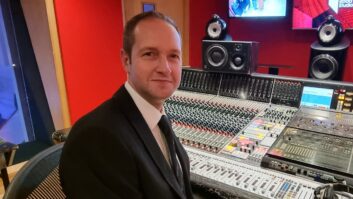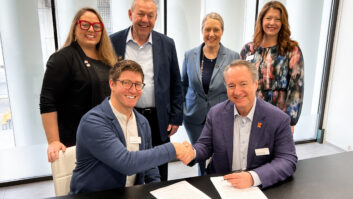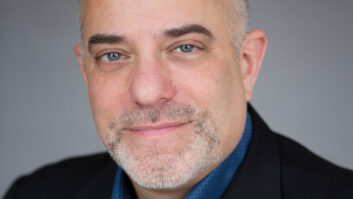Last month, CEDIA elected Ray Lepper as its new president after a successful two years of leadership from Jeff Hoover. Lepper is the former head of British loudspeaker manufacturer, KEF Audio, and current president of Home Media Stores, L.C. a Richmond, Virginia-based home systems integration company. He has been an active volunteer for CEDIA since 1998, having served as its vice president for the past two years. Lepper recently spoke with Residential Systems editor, Jeremy Glowacki, outlining his goals and vision for the association.
Jeremy Glowacki: In the short time since EXPO, describe your transition from vice president to president. I’m aware that you have already appointed your committee chairs. Sounds like you’re off to a running start.
Ray Lepper: This time was probably the smoothest transition and preparation, because we’ve learned the right way to do it over the years. You have to go back into the history where in our bylaws, the president has the right to appoint councils, committees and action teams and their chairs to his satisfaction. In the past, he basically made all of those appointments himself. Well, the organization has gotten so large in terms of its volunteer structure that for a single guy to even know who all of those people should be is impossible now.
There are so many people on the ground working on very specific projects that he might know the top level, but what we’ve come to realize is that the council chairs themselves should be largely responsible for appointing their action team chairs. In terms of hierarchy, there’s the board of directors and the executive committee. Below the board are these five council chairs and below those is a sub-unit called “action team.” And action team is not a “forever” organization; it has a very specific task or job to do, and when it’s done with that job, it may very well just disappear, and those volunteers will re-form around other jobs. This year, with the hope that I would be elected president [at EXPO], I had a meeting with the executive committee and talked about recommendations for council chairs ahead of time. I also got input from the executive staff–the people that we pay to run the association–and I had recommendations from the existing council chairs. As a result, it was very much a consensus process where all of the appointments that were made were absolutely on track with everybody’s recommendations.
So bring us up to speed on the existing councils and what has changed.
There’s Membership, Manufacturers, Education, Certification and Industry Events & Outreach. Certification used to be an action team within the Education Council, and we broke it out as a separate council, because it is now a core product of CEDIA and a separate product from education. What we’ve discovered, however, is that all of the really cool things that we’re going to be working on in coming years do not fit neatly within a single council. All of our work just got more complex, because our success now depends on our ability to bring a lot of pieces together. It’s just like a big company. When you have a big project, everybody’s got a piece of it. The only way you cross the goal line is if all of the team members know their roles.
Looking ahead into you CEDIA presidency, what are some of your initial goals and objectives?
I want to continue the development of our education system and products. We really are going to make a thing called CEDIA University. It’s not bricks and mortar; it’s the notion or concept of a core curriculum. If you enter into it, you will start with a very clear understanding of what you’re going to emerge knowing and being able to do. On top of that core curriculum we’re going to establish areas of specialization, where someone can become very competent in a specialized area or discipline. Our goal is to continue to formalize and make our education product more valuable. A lot of the courses we do now are really seminars. They’re overview courses taught by engaging personalities, but they’re not what you would call core curriculum. We’re on track to fix that and make the education product more valuable.
Another thing that we’re going to do is raise the standards for CEDIA membership. We’re going to use a process of raising the bar for ourselves, letting people know what will be expected one year from now, two years from now, etc., so that the CEDIA logo will really mean something. [A membership] will have requirements for length of time in business, number of certified employees and continuing education. We’re not looking to throw anyone out or leave anybody behind, but what we are saying is that the bar is going to be raised, and you will have to keep up. It will be achievable, and we’re going to provide the mechanisms to do it, but it’s going to be up to individual companies to make the commitment to be the best. We want the CEDIA logo to mean something more to consumers, manufacturers, architects, builders and designers.
How do you accommodate all of the individuals who want to be trained? It seems that the model is through regional education and EXPO, but it still seems difficult to stay on the curriculum path, because classes aren’t always available when you need them. Am I wrong?
No, that’s a good point. One of the Education Council’s primary objectives since it was formed is more education, more often, in more venues. You’ll see our partnership at EH Expo and our classes at CES as ways of doing that. The recent partnership with TechHome and the fact that we are going to embrace the EST curriculum that has been blessed by the federal government, could potentially do that too. We’re looking to provide more opportunities for people to get core education and to get certified than what we can supply through our own events. If you look at what that means, by partnering we’re more than doubling the opportunity, and that effort will continue.
How much will your instructor lineup change as the curriculum becomes for standardized?
We started an initiative last year to develop an instructor pool of folks who met certain standards and who were really vetted. What we’re looking for is not someone who just has one course that he or she can teach. Instead, by developing a set of core curriculum courses and a pool of qualified instructors, we can match those two things up and deliver a professional, consistent education product. Those will not be seminars; they are going to be real classes, and they’re going to have workbooks and quizzes. We’ll still have seminars, but they’re more like the electives or the enrichment courses.
Back to what you said about the requirements for membership, is this going to be something that will be evaluated annually?
I don’t want to get too far out in front of the Membership Council’s work. Their job is to define what “raising the bar” looks like for the next four or five years. It will certainly include classic CEDIA values, which is really smart people, who are well trained (and can prove it) and the employment of certified professionals. It also will mean that you can furnish your licensing–that you really do comply with local licenses. It will have a time component, as well. The barriers to entry in our industry are extremely low, and that’s a good thing. That means we can create jobs, and people can start new businesses. But if CEDIA is going to mean anything topeople, it’s got to have a set of standards that you really have to work hard to get to. It shouldn’t be just automatic, or it means nothing.
Changing gears… what would you say is the most-lasting legacy left by your predecessor, Jeff Hoover?
In terms of things that he’s going to leave behind that just won’t disappear, the absolute thing is the Idea Bank. This thing is huge. He and his company spent an enormous amount of money just building it and giving it to CEDIA, because he believed in it that much. So this is a massive legacy for Jeff. The other thing is that Jeff is truly “a what you see is what you get” kind of guy. He does not have a hidden agenda. He will present his point of view forcefully, but having said that, you can change his mind if you make your point effectively. It’s a great combination being passionate about something but also being able to turn on a dime when a better idea comes along. I really respect his ability to think something through like that, and he’s able to be a really good leader because of that.
What initiatives of Jeff’s will you continue?
All of them. The reason is that Jeff and I were in alignment on everything. We might have started out with different views on a subject, but by the time we as a board took action, Jeff and I were in parallel. This is why having him around for two more years [as past-president] is huge benefit to me. He’ll be a supporter as I continue some of the same directional things that he started.
How would you describe your role as president of CEDIA. What will you do to help enable change during your tenure?
I see my role as knocking obstacles out of the way so that people can succeed. In a way that’s what a coach does and that’s what a facilitator does. I look around and say “Do we all agree that this is what we want to accomplish? I want you guys to go do it, and tell me if there’s something keeping you from getting it done, and I’ll go figure out how to get it out of the way.” I don’t want to be the guy who does it all, but I do want to be the guy who pulls it together for people so that their work comes together.
What are some of the other areas that you will promote as part of your presidential “platform,” if you will?
Public policy and legislative action. CEDIA really did grow an industry in the U.S. We grew it from nothing into something that’s really worth a lot of money, and a lot of people want a piece of it. But what we see now is that some folks would like to legislate us out of our jobs. What’s ironic about that is that in most attempts to do that, it’s people that can’t do the work we do. I’d like to see legislation in all 50 states that provides for licensing and testing in our specialty that is based on real technical and business skills which are necessary to protect consumers and the industry as a whole. I think standards are good.
I think legislation is good. I think those things can be developed voluntarily by the industry. It doesn’t do anybody any good to have lousy work being done in the field. It will also create a level playing field for anybody who wants to compete doing good work.
It seems like that goes hand in hand with improved education.?
Yes, it’s a tree-legged stool. If you’ve got education, certification and public policy, legislation and licensing, then this thing stands up. On the one hand, you’re saying “these are standards that are good for consumers and the industry. We’ve got a certification program to test that people know their stuff and we’ve got an education program to get them ready to take those tests.” So then we’d really be performing a proper service for the industry.
Those are some issues that are affecting the industry, but what about other competitive challenges such as the encroachment of the IT world. With the industries converging, what is CEDIA doing to keep up with changing technology?
I think that it’s actually easier for the A/V guys to keep up with it, in a way, than the IT guys. It’s interesting that you have people from ISF [Imaging Science Foundation] to consult with Microsoft about digital video, and it’s interesting that the first soundcards just really sucked, because they didn’t get it about audio. We’ve already established quality standards and been a part of those standards in analog. All that digital does, really, is move it and store it. It always turns back into analog for the ears and eyes to experience. Analog is always going to exist, and analog is human. I think these two sides are coming together nicely, and I don’t feel any threat at all by the digital guys coming into the world. They just facilitate the delivery of all of this great content–storing it, moving it, taking it with you, controlling it. They make it easier for us to do cooler things. We’re still experts at performance. Room acoustics is highly analog and RGB video is highly analog. So we have a real reason to live.
What about the influx of technicians from the IT world? Will this prove to be a good or bad thing for CEDIA?
It’s great. We don’t have enough trained people. We need a lot of smart people to run these businesses. They have good skills, and a lot of those skills are parallel to what we do in terms of engineering and design and programming.
Will there be in a day in the not-too-distance future when everything will be such a commodity, that CEDIA won’t need to exist anymore?
I think about this every day. Commoditization is what the markets do to everything. That’s inescapable. CEDIA members exist at the point of friction between what customers want a technology to do and what the off-the-shelf technology can do. We exist to make those two things come together. Commoditization eliminates the friction. The off-the-shelf product is good enough to meet the customer’s need and there isn’t any friction. The average VCR… fine. You can’t add much value to a VCR, but the promise of plug and play (the absence of friction) is a worthy goal that is in the interest of the producer and consumer of that technology. All new technology, when it comes out is not plug and play. It’s never plug and play. So service providers (CEDIA members) hide that friction from the end-user, and they hide that friction on behalf of the manufacturer.
We can sell products that don’t work, because we make them work. We don’t need mass quantities; we just need a little of the right stuff. We provide for manufacturers a gateway to early adopters and premium purchasers of the newest technology that is expensive and doesn’t quite work. That actually is a really useful function for manufacturers. As long as they keep making stuff that’s in that sort of cycle, then friction reducers like CEDIA members have a place to be. It will always have words like “high-end” because it expensive and not widespread. That’s the technical part, but the other role matches up more with the “design professional” on a custom home. I think that more and more CEDIA members are going to deliver value by serving as design professionals. Like architects and interior designers, we try to get inside the heads of our clients, figure out how they really want to live and bring the world to them in a package, all done, that makes them happy. So we’re in the do-it-for-you business. Do it yourself… or we’ll do it for you.
There have been some notable business failures from CEDIA dealers in the past year. As CEDIA president and a business owner yourself, what lessons can these closings teach us?
First, never kid yourself about the financial situation within your company. Also, react sooner rather than later and remember that this is just a business. I know that we love our companies, but they are machines or vehicles for what we do; they are not “us.” If the machine is broken or the vehicle is really running off the road, then passion and energy alone will not correct it. It’s about numbers, and those numbers don’t lie. You have to deal with them and deal with them fast.
Are you optimistic about the future?
I am. I don’t think it’s wise for anyone to go out and make massive investments in people and equipment right now. I think it is appropriate for people to be planning on growing. My company has plans to add a little more overhead, do some improvements to our physical space and to our people. They’re modest, conservative plans, but I think they’re the right things to do. I think that we should be conservative but keep trying to push uphill. I really do believe that the worst is yet behind us, and that we’re going to continuously see small improvements. Remember that in our industry the pipeline is very long. Some of guys who you see falling over today were hit by a bullet that was fired 18 months ago. It just took this long to get there. The reality is that there’s a big dry spot in the pipeline of new business coming to them and they couldn’t breathe through the vacuum, but they didn’t see it coming.







